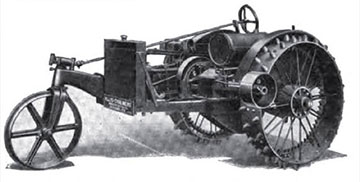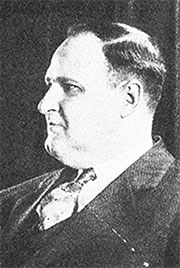|
Prior Page
Next Page
A Slow Start for Farm Equipment |
|---|
| 1912 |
 During
a period of financial trouble, the Allis-Chalmers Company is reorganized as the Allis-Chalmers Manufacturing Company.
Otto Falk, a former General with the Wisconsin National Guard is appointed to lead the company moving forward. Falk champions the company's expansion
into new markets and sees an opportunity as farmers are beginning to embrace
kerosene fueled tractors and other labor-saving machines. During
a period of financial trouble, the Allis-Chalmers Company is reorganized as the Allis-Chalmers Manufacturing Company.
Otto Falk, a former General with the Wisconsin National Guard is appointed to lead the company moving forward. Falk champions the company's expansion
into new markets and sees an opportunity as farmers are beginning to embrace
kerosene fueled tractors and other labor-saving machines. |
| 1914 |
 Allis-Chalmers enters the farm tractor business with the introduction of the 10-18.
The 10-18 features a two-cylinder opposed engine, a green and red paint scheme, and sells for $750.
In total less than 200 are sold ending in 1923 and only a few examples
survive today. Allis-Chalmers enters the farm tractor business with the introduction of the 10-18.
The 10-18 features a two-cylinder opposed engine, a green and red paint scheme, and sells for $750.
In total less than 200 are sold ending in 1923 and only a few examples
survive today. |
| 1918 |
 Farm tractor designs are evolving rapidly and in just a few years
Allis-Chalmers introduces the Model E or 18-30. This design is much more successful and
keeps Allis-Chalmers
in the tractor business during an otherwise unimpressive period. The Model E later receives horsepower
upgrades to 20-35
and eventually 25-40. Production of the Model E ends in 1936 with over
20,000 units produced. Farm tractor designs are evolving rapidly and in just a few years
Allis-Chalmers introduces the Model E or 18-30. This design is much more successful and
keeps Allis-Chalmers
in the tractor business during an otherwise unimpressive period. The Model E later receives horsepower
upgrades to 20-35
and eventually 25-40. Production of the Model E ends in 1936 with over
20,000 units produced. |
| 1919 |
 Many companies are building tractors designed to be used with horse-drawn
implements farmers already own. The 6-12 is Allis-Chalmers' take on this concept. In seven years
of production, over 1,000 are produced, but
demand quickly fades as farmers see the advantages of bigger tractors and implements. Many companies are building tractors designed to be used with horse-drawn
implements farmers already own. The 6-12 is Allis-Chalmers' take on this concept. In seven years
of production, over 1,000 are produced, but
demand quickly fades as farmers see the advantages of bigger tractors and implements. |
| 1921 |
 The
small and affordable Model L 15-25 is introduced with the up-and-coming farmer
in mind.
Management has high hopes for the L, but there is fierce competition in this
space and during it's six years of production only 1,705 are built. The
small and affordable Model L 15-25 is introduced with the up-and-coming farmer
in mind.
Management has high hopes for the L, but there is fierce competition in this
space and during it's six years of production only 1,705 are built. |
| 1926 |
 Otto Falk brings in Harry Merritt to help breathe life into the struggling farm tractor division. Merritt has a successful track record with several brands of farm and construction equipment, most notably the Holt company. It is Merritt who in 1929 will find inspiration in a field of California poppy blossoms to start painting Allis-Chalmers tractors Persian orange. Otto Falk brings in Harry Merritt to help breathe life into the struggling farm tractor division. Merritt has a successful track record with several brands of farm and construction equipment, most notably the Holt company. It is Merritt who in 1929 will find inspiration in a field of California poppy blossoms to start painting Allis-Chalmers tractors Persian orange. |
| 1928 |
 The Monarch Tractor Company of Springfield, Illinois is acquired. This gives Allis-Chalmers a foothold in the crawler tractor business. The Monarch Tractor Company of Springfield, Illinois is acquired. This gives Allis-Chalmers a foothold in the crawler tractor business. |
| 1929 |
 The "U"
is introduced as a smaller alternative to the popular Model E. While the "U" is
never a run-away success, it does have a spot in agriculture history as the
first farm tractor to be widely promoted with rubber tires. Merritt knew Harvey
Firestone and enlisted his help to develop a tire specifically for farm tractor
applications. In the early 1930's this is a radical idea, but tests prove the
tires to superior to lugged steel wheels in every regard. The "U" remains in the line all the way to
1953 and over 20,000 units are sold. The "U"
is introduced as a smaller alternative to the popular Model E. While the "U" is
never a run-away success, it does have a spot in agriculture history as the
first farm tractor to be widely promoted with rubber tires. Merritt knew Harvey
Firestone and enlisted his help to develop a tire specifically for farm tractor
applications. In the early 1930's this is a radical idea, but tests prove the
tires to superior to lugged steel wheels in every regard. The "U" remains in the line all the way to
1953 and over 20,000 units are sold. |
| 1931 |
 The Advance-Rumely Company of La Porte, Indiana is acquired giving Allis-Chalmers an established farm equipment dealer network with
over 2,000 locations.
Rumely has struggled to modernize their highly regarded line of equipment. Remaining inventory is sold through the new Allis-Chalmers dealers,
often with updated badges bearing the Allis-Chalmers name. The Advance-Rumely Company of La Porte, Indiana is acquired giving Allis-Chalmers an established farm equipment dealer network with
over 2,000 locations.
Rumely has struggled to modernize their highly regarded line of equipment. Remaining inventory is sold through the new Allis-Chalmers dealers,
often with updated badges bearing the Allis-Chalmers name. |
|
Prior Page
Next Page
|
|---|

 During
a period of financial trouble, the Allis-Chalmers Company is reorganized as the Allis-Chalmers Manufacturing Company.
Otto Falk, a former General with the Wisconsin National Guard is appointed to lead the company moving forward. Falk champions the company's expansion
into new markets and sees an opportunity as farmers are beginning to embrace
kerosene fueled tractors and other labor-saving machines.
During
a period of financial trouble, the Allis-Chalmers Company is reorganized as the Allis-Chalmers Manufacturing Company.
Otto Falk, a former General with the Wisconsin National Guard is appointed to lead the company moving forward. Falk champions the company's expansion
into new markets and sees an opportunity as farmers are beginning to embrace
kerosene fueled tractors and other labor-saving machines. Allis-Chalmers enters the farm tractor business with the introduction of the 10-18.
The 10-18 features a two-cylinder opposed engine, a green and red paint scheme, and sells for $750.
In total less than 200 are sold ending in 1923 and only a few examples
survive today.
Allis-Chalmers enters the farm tractor business with the introduction of the 10-18.
The 10-18 features a two-cylinder opposed engine, a green and red paint scheme, and sells for $750.
In total less than 200 are sold ending in 1923 and only a few examples
survive today. Farm tractor designs are evolving rapidly and in just a few years
Allis-Chalmers introduces the Model E or 18-30. This design is much more successful and
keeps Allis-Chalmers
in the tractor business during an otherwise unimpressive period. The Model E later receives horsepower
upgrades to 20-35
and eventually 25-40. Production of the Model E ends in 1936 with over
20,000 units produced.
Farm tractor designs are evolving rapidly and in just a few years
Allis-Chalmers introduces the Model E or 18-30. This design is much more successful and
keeps Allis-Chalmers
in the tractor business during an otherwise unimpressive period. The Model E later receives horsepower
upgrades to 20-35
and eventually 25-40. Production of the Model E ends in 1936 with over
20,000 units produced. Many companies are building tractors designed to be used with horse-drawn
implements farmers already own. The 6-12 is Allis-Chalmers' take on this concept. In seven years
of production, over 1,000 are produced, but
demand quickly fades as farmers see the advantages of bigger tractors and implements.
Many companies are building tractors designed to be used with horse-drawn
implements farmers already own. The 6-12 is Allis-Chalmers' take on this concept. In seven years
of production, over 1,000 are produced, but
demand quickly fades as farmers see the advantages of bigger tractors and implements. The
small and affordable Model L 15-25 is introduced with the up-and-coming farmer
in mind.
Management has high hopes for the L, but there is fierce competition in this
space and during it's six years of production only 1,705 are built.
The
small and affordable Model L 15-25 is introduced with the up-and-coming farmer
in mind.
Management has high hopes for the L, but there is fierce competition in this
space and during it's six years of production only 1,705 are built. Otto Falk brings in Harry Merritt to help breathe life into the struggling farm tractor division. Merritt has a successful track record with several brands of farm and construction equipment, most notably the Holt company. It is Merritt who in 1929 will find inspiration in a field of California poppy blossoms to start painting Allis-Chalmers tractors Persian orange.
Otto Falk brings in Harry Merritt to help breathe life into the struggling farm tractor division. Merritt has a successful track record with several brands of farm and construction equipment, most notably the Holt company. It is Merritt who in 1929 will find inspiration in a field of California poppy blossoms to start painting Allis-Chalmers tractors Persian orange. The Monarch Tractor Company of Springfield, Illinois is acquired. This gives Allis-Chalmers a foothold in the crawler tractor business.
The Monarch Tractor Company of Springfield, Illinois is acquired. This gives Allis-Chalmers a foothold in the crawler tractor business. The "U"
is introduced as a smaller alternative to the popular Model E. While the "U" is
never a run-away success, it does have a spot in agriculture history as the
first farm tractor to be widely promoted with rubber tires. Merritt knew Harvey
Firestone and enlisted his help to develop a tire specifically for farm tractor
applications. In the early 1930's this is a radical idea, but tests prove the
tires to superior to lugged steel wheels in every regard. The "U" remains in the line all the way to
1953 and over 20,000 units are sold.
The "U"
is introduced as a smaller alternative to the popular Model E. While the "U" is
never a run-away success, it does have a spot in agriculture history as the
first farm tractor to be widely promoted with rubber tires. Merritt knew Harvey
Firestone and enlisted his help to develop a tire specifically for farm tractor
applications. In the early 1930's this is a radical idea, but tests prove the
tires to superior to lugged steel wheels in every regard. The "U" remains in the line all the way to
1953 and over 20,000 units are sold. The Advance-Rumely Company of La Porte, Indiana is acquired giving Allis-Chalmers an established farm equipment dealer network with
over 2,000 locations.
Rumely has struggled to modernize their highly regarded line of equipment. Remaining inventory is sold through the new Allis-Chalmers dealers,
often with updated badges bearing the Allis-Chalmers name.
The Advance-Rumely Company of La Porte, Indiana is acquired giving Allis-Chalmers an established farm equipment dealer network with
over 2,000 locations.
Rumely has struggled to modernize their highly regarded line of equipment. Remaining inventory is sold through the new Allis-Chalmers dealers,
often with updated badges bearing the Allis-Chalmers name.